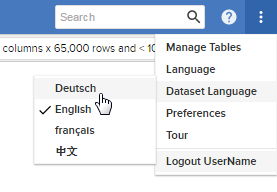Multilingual and Localisation Support - SuperWEB2
SuperWEB2 supports multiple languages for both the user interface and the dataset.
User Interface Language
When users log in to SuperWEB2 it will automatically select the most appropriate language for the user interface, based on the list of accepted languages sent by the user's web browser. Users can choose a different language by selecting from the drop-down list in the top right corner.

This means that if you have a mixture of users in different locations you can configure SuperWEB2 to support all the languages that your users speak.
Predefined Language Support
SuperWEB2 is supplied with user interface translations (or "resource bundles") for:
- English
- Simplified Chinese
- German
- Arabic
- Russian
Create your Own Localisation
If you need to support a language that is not already included with SuperWEB2, then you can create your own resource bundle containing the appropriate translations.
To add support for additional languages, you need to:
- Provide translations for all of the user interface strings.
- Configure SuperWEB2 to support the additional language.
Learn More: Add a User Interface Language - SuperWEB2.
Set the Default Language
You can also select the default language on your system: this is the language that SuperWEB2 will use if the list of accepted languages sent by the user's web browser does not match any of the languages SuperWEB2 has been configured to support. By default, this is configured to be English, but you can choose a different default language if necessary.
Learn More: Change the Supported User Interface Languages - SuperWEB2.
Change the Language Displayed to Users
If your users are not seeing the user interface of SuperWEB2 displayed in the correct language:
- Make sure you have followed the steps to add the resource bundle for this language (if necessary) and have configured SuperWEB2 to support this language.
- Ask the user to check their browser language settings or select the language from the drop-down list.
Dataset Language
In addition to supporting multiple user interface languages, SuperWEB2 can also be configured to support multiple dataset languages. This means that you can translate the text strings and labels that appear in your data (such as the names of fields, classifications, and summation options) and allow users to select which language they want to see.
To enable multilingual datasets, you need to set up Metadata Server, and populate the metadata database with the translations for all the fields in your dataset. Once this has been configured and you have activated multilingual datasets in SuperADMIN, SuperWEB2 will display a second language selector, where users can select their preferred dataset language:

Learn More: Set Up - Metadata Server
SuperWEB2 will use the list of accepted languages sent by the user's web browser when determining which language to show for datasets by default. If the languages sent by the user's browser do not match any of the available dataset languages, then it will use the <default-locale> setting configured in the faces-config.xml configuration file.
